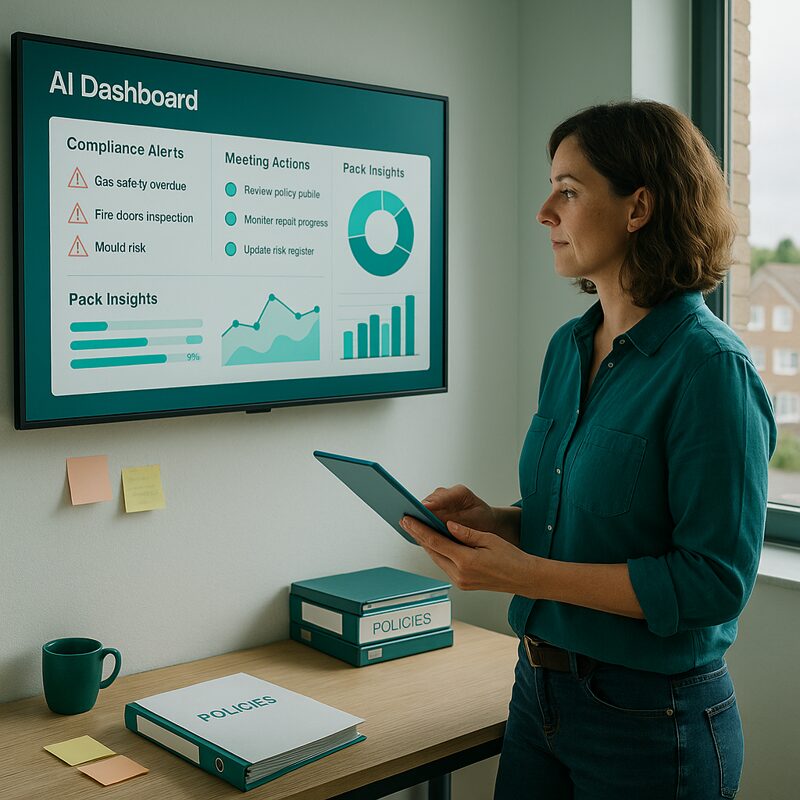A version of this blog was featured in Housing Digital
6 p.m., board pack day.
It’s 6 p.m. on pack day. Non-exec David is knee-deep in 284 pages he must sign off in 48 hours — from gas safety to tenant satisfaction. CEO Sally is firefighting press calls on damp and mould, with Awaab’s Law cutting inspection deadlines to 14 days and repairs to seven.
Across the sector, two-thirds of staff have tried generative AI, but boards remain paper-heavy. Packs average nearly 300 pages and take nine hours to read. Directors skim, risks get buried, and decisions rest on partial insight. It’s like steering a ship in fog with outdated charts. With a £4.5bn repairs backlog and regulators demanding real-time evidence, governance is flying blind.
The storm isn’t coming—it’s already here. The question is: can we steer the next cycle using yesterday’s data?
Board Pain points—one breath
- Regulatory overload. Awaab’s Law and the new consumer standards squeeze deadlines into a week. Boards juggle 20+ KPIs, fearing downgrades more than driving strategy.
- Scattered data. Gas certificates sit in one system, tenant sentiment in another. Teams spend weeks stitching datasets together—and still risk audit gaps.
- Pack bloat. At 280 pages, key risks get buried in Appendix C.
- Skills gap. TSM, ESG, IoT—acronyms multiply faster than training budgets.
- Admin drag. Five staff hours disappear in every meeting, just to chase actions and write minutes.
For David, this is about assurance: can he honestly assure himself that the risks are covered? For Sally, it’s about capacity: how can her teams focus on tenants while buried in admin? For tenants, it’s about trust: will anyone spot damp, mould, or missed safety checks before the regulator or the press do?
Potential Solution: a VBE?
Think of a Virtual Board Executive (VBE) as a board-grade copilot that plugs into what you already have.
Under the bonnet, it’s a secure, private GenAI instance trained on your standing orders, codes of governance, policies, asset registers, and live performance feeds. Unlike ChatGPT, it never sends data outside the building. Above the bonnet, it behaves less like “tech” and more like the best committee clerk, analyst, and action-chaser you’ve ever had.
In plain terms, it’s like having your own governance PhD advisor — steeped in your organisation’s context, always available, and never tired. Or, to use another analogy, it’s a satnav for governance: it guides you through complexity, but directors still drive the car.
With a VBE, directors can:
– Ask: “What does the new electrical safety standard require by Q3?” → get a 30-second answer with hyperlinked clauses.
– Analyse: Drop in a draft paper → receive a 100-word summary plus three challenge questions.
– Act: Auto-draft minutes, assign actions, and track them until closure.
This isn’t about replacing judgment or giving an avatar a vote. It’s about a context-aware assistant that sweats the data so the people around the table can focus on debate and decisions.
As Vipin Gupta recently put it in MIT Sloan Management Review, Gen AI personas can form a round-the-clock “personal board of directors”—rotating voices, raising new perspectives, and staying within guardrails.
Not a new idea—AI board assistants are already in the room
- Aiden Insight (G42 / Microsoft)—models commodity and geopolitical shocks live in a sovereign-fund audit committee, giving directors “what-ifs” they once waited weeks for.
- Arya (Real Bodics)—Japanese robotics board gets market-shift briefs from its AI non-exec before each strategy review.
- Diligent Gen AI search—directors ask, “Show every minute on cladding risk,” and get instant cross-meeting extracts.
- PersonalBoard.ai & DAB Insight—spin-up, on-demand AI “directors” for scale-ups and mid-caps.
- JPMorgan GPT + Microsoft 365 Copilot—condense thousands of data points into board-ready snapshots inside familiar Office apps.
- Harvey at Allen & Overy—legal-grade AI parses contracts and compliance checklists, showing regulators trust machine precision.
- Lucia—UK board-pack tool trims page count by ~15 % and flags missing insights.
- PwC compliance bot—overnight rule-scan emails a one-page “act/ignore” brief to boards before breakfast.
- Deloitte insight—predicts AI board observers will be table stakes within three years.
Pattern: in every case the AI works as a copilot, not a voter—cutting noise, surfacing risk and leaving judgement firmly with human directors.
Where VPEs Move the Needle—and Satisfies the Regulator
A VPE pilot isn’t “tech for tech’s sake.” It’s designed to land squarely against the four pillars of the Regulator of Social Housing (RSH).
Governance — Boards make informed, timely decisions and keep full records.
• Immutable audit trail of every AI output (time-stamped, source-linked)
• Human sign-off before minutes are finalised
Viability — Resources used efficiently; financial exposure understood.
• ≥5 staff hours saved per meeting → logged in ROI snapshot
• Dashboard flags budget variances on AI running costs
Safety & Quality — Compliance risks (e.g., damp, gas, fire) surfaced promptly.
• Alerts flag overdue FRA/TSM actions within 24 hours
• Log auto-exports to compliance register for inspection readiness
Transparency & Accountability — Stakeholders can scrutinise decisions and performance.
• Packs reduced by 15% → risks and decisions clearer
• All director queries stored and retrievable on request
For David, this means assurance he can evidence in seconds, not weeks. For Sally, it means scarce hours are released to focus on repairs, complaints, and tenant satisfaction. For tenants, it means stronger governance that delivers safer homes, faster fixes, and clearer accountability.
ROI Snapshots: Before, During, After
Before meetings (prep efficiency): Lucia cut pack length by 15%, saving ten hours per cycle. A European bank reported a 45% reduction in prep time — nine hours of reading condensed into concise digests.
– During meetings (meeting efficiency): AI copilots strip away noise so directors spend more time on strategy and tenant outcomes.
– After meetings (post-meeting support): Minutes drafted in under ten minutes, actions logged, and reminders issued automatically. In housing pilots, governance officers saved £12,000 annually.
– Digital fluency: A short walkthrough and plain-English explainers close literacy gaps fast.
The payback: Most pilots land full ROI within nine months. Scaled across 200 housing associations, VPEs could free thousands of governance hours and save the sector millions in admin costs while reducing risk and improving outcomes.

Objections & guardrails: Turning Doubts into Design
– “We’re risk-averse.” Run the VPE in shadow mode as a rehearsal. David tests accuracy; Sally proves value; tenants gain confidence.
– “Our data isn’t good enough.” Start with a 30-day data cleanse of safety and asset records. David trusts insights; Sally shows regulators evidence; tenants see earlier warnings.
– “Black-box tech undermines accountability.” Every alert carries a full audit log; explainability and override are mandatory. David gets a flight recorder; Sally strengthens trust; tenants get accountable decisions.
– “We don’t have the skills.” Use a sandbox — a secure rehearsal room — to test safely. David checks line by line; Sally avoids costly hires; tenants benefit from faster rollouts.
– “Our board isn’t digitally fluent.” Provide a short walkthrough and explainer cards. David feels confident; Sally builds team capacity; tenants benefit from sharper governance.
Handled this way, objections become design principles: start small, clean the data, keep humans in the loop, and build digital confidence. That shifts the debate from ‘Should we risk AI?’ to ‘Can we risk governing without it?’
Six‑Step Roadmap:Safe, Practical, Measurable
The path to a VPE isn’t a leap—it’s a series of small, safe steps. Each one can be funded from existing budgets, each one big enough to earn trust.
Step 1 (0–2 months): Build the sandbox.
Set up an AI task group (Board Secretary, IT/InfoSec, DPO, Directors). Publish a one-page charter on “human in the loop” rules. Cleanse core governance data so the pilot starts on solid ground.
Step 2 (2–5 months): Train the governance chatbot.
Spin up a private GPT and load it with standing orders, NHF Code, RSH standards & TSMs, the Social Housing Act, consumer standards, Awaab’s Law, and your governance policies. Test it on real board queries—for example: “What does Awaab’s Law require within 14 days?” Target: a clear, linked answer in 30 seconds.
Step 3 (5–7 months): Shadow pilot with directors.
Bob and Sally trial the chatbot alongside normal packs. Capture misses, fine-tune sources, tag everything for audit. Success is measured by six KPIs:
- Minutes accuracy ≥90% of actions captured
- Draft minutes turnaround ≤10 minutes
- Board pack length reduced by ≥15%
- Chatbot answer precision ≥90%
- Director adoption ≥80% by month 4
- At least 5 admin hours saved per meeting
Step 4 (7–11 months): Add the AI meeting assistant.
Introduce speech-to-text to draft minutes and email actions before people leave the room. That alone cuts prep by ~5 hours per sitting, matching results already proven by sector peers.Non-profits using Boardable’s AI note-taker shaved a similar five hours per meeting, so the savings is hardly theoretical.
Step 5 (11–15 months): Integrate with the board portal.
One login. One search bar. Everything in one place.
Step 6 (15–18 months): Measure and extend.
Publish a benefits scorecard (time saved, compliance queries answered). Share results with the regulator. Then choose the next committee to pilot.
Conclusion:From Paperwork to Assurance
The tech is already here. Better to shape it than scramble to catch up.
Start small: pilot a VPE against one tough governance challenge. Keep humans firmly in the loop. Let the numbers make the argument.
Eighteen months from now, the payoff should be obvious:
- Board members open a board pack half the size yet twice as clear.
- Execs brief the press with live, trusted data at their fingertips.
- Tenants see the difference where it matters most: safer homes, faster repairs, a stronger voice.
That’s not AI hype. That’s governance working as it should.
Check out our other resources on this topic namely
Briefing the Board on AI: Educate to Inspire Investment
David’s AI Journey: Curated Insights for Social Housing Boards





